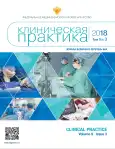Long-term outcome of the laparoscopic repair of hiatus hernia
- Authors: Burikov M.A.1, Skazkin I.V.1, Shulgin O.V.1, Kinyakin A.I.1, Sokirenko I.A.2
-
Affiliations:
- Federal Medical and Biological Agency of Russia (FMBA), Southern District Center of Medicine, Rostov Clinical Hospital
- Rostov State Medical University
- Issue: Vol 9, No 3 (2018)
- Pages: 26-33
- Section: Original Study Articles
- URL: https://journals.rcsi.science/clinpractice/article/view/10678
- DOI: https://doi.org/10.17816/clinpract09326-33
- ID: 10678
Cite item
Full Text
Abstract
Presently, the improvement in the quality of life of patients who underwent a laparoscopic surgical repair of hiatus hernia and the absence of the gastroesophageal reflux disease (GERD) recurrence are the basic characteristics of the surgical treatment. In this connection, further perfection of the tactics and techniques of the surgical GERD treatment becomes an important problem of modern surgery.
Here, we present a comparative analysis of the remote results of the surgical treatment of 159 patients with GERD-complicated hiatus hernia. The patients were divided into two groups, depending on the technique of the performed endosurgical treatment. The first group consisted of patients operated via the standard laparoscopic Nissen fundoplication. In the second group, we included those patients who underwent surgical treatment using a modified procedure of Nissen fundoplication with the formation of a non-tension cuff (RF patent No. 2529415 of 27.09.2014).
Evaluation of the results, based on the survey questionnaires Gerd-Q, GSRS, SF-36 and the data of instrumental research methods, was performed 1 to 5 years post-treatment.
The treatment of the GERD-complicated hiatus hernia patients with application of the technique of forming a non-hanging fundoplication cuff shows the best long-term results: the incidence of the reflux syndrome and signs of hyperfunction of the fundoplication cuff is lower. The revealed differences coincide with the data of the Gerd-Q and GSRS questionnaires, as well as the life quality estimation by the SF-36 questionnaire. The developed techniques do not require application of sophisticated technical skills and re-equipment and may be recommended for the practical use in the everyday practice in surgical hospitals of all levels.
Full Text
##article.viewOnOriginalSite##About the authors
M. A. Burikov
Federal Medical and Biological Agency of Russia (FMBA), Southern District Center of Medicine, Rostov Clinical Hospital
Author for correspondence.
Email: burikovm@gmail.com
к.м.н., заведующий хирургическим отделением Ростовской клинической больницы Южного окружного медицинского центра ФМБА России
Russian Federation, Rostov-on-DonI. V. Skazkin
Federal Medical and Biological Agency of Russia (FMBA), Southern District Center of Medicine, Rostov Clinical Hospital
Email: skazkini@gmail.com
к.м.н., врач-хирург Ростовской клинической больницы Южного окружного медицинского центра ФМБА России
Russian Federation, Rostov-on-DonO. V. Shulgin
Federal Medical and Biological Agency of Russia (FMBA), Southern District Center of Medicine, Rostov Clinical Hospital
Email: shoolgin@gmail.com
врач-хирург, заведующий трансфузиологическим кабинетом Ростовской клинической больницы Южного окружного медицинского центра ФМБА России
Russian Federation, Rostov-on-DonA. I. Kinyakin
Federal Medical and Biological Agency of Russia (FMBA), Southern District Center of Medicine, Rostov Clinical Hospital
Email: iskander0307@gmail.com
врач-хирург Ростовской клинической больницы Южного окружного медицинского центра ФМБА России
Russian Federation, Rostov-on-DonI. A. Sokirenko
Rostov State Medical University
Email: sokirenkoirina@ya.ru
аспирант кафедры хирургических болезней № 1 РостГМУ
Russian Federation, Rostov-on-DonReferences
- Geremy R., Sheraz Z., Melody Z. еt al. Laparoscopic repair of hiatus hernia: Does mesh type influence outcome? A meta-analysis and European survey study // Surgical Endoscopy. 2016. Vol. 12. P. 5209–5221.
- Krenk L., Кehlen H., Hansen T. еt al. Cognitive dysfunction after fast-track hip and knee replacement // Anesthesia & Analgesia. 2014. No. 5. P. 1034–1040.
- Pitter F., Jørgensen С, Lindberg-Larsen M. еt al Postoperative morbidity and discharge destinations after fast-track hip and knee arthroplasty in patients older than 85 years // Anesthesia & Analgesia. 2016. No. 6. P. 1807–1815.
- Буриков М.А., Сказкин И.В., Шульгин О.В. и др. Анализ ранних послеоперационных осложнений у пациентов после лапароскопического лечения ГПОД // Клиническая практика. 2017. № 1. С. 46–49.
- Буриков М.А., Сказкин И.В., Шульгин О.В. Гастроэзофагеальная рефлюксная болезнь. Дифференцированный подход к протезированию диафрагмы в антирефлюксной хирургии // Журнал фундаментальной медицины и биологии. 2014. № 1. С. 4–6.
- Буриков М.А., Кинякин А.И., Шульгин О.В. Применение импланта на основе коллагена в пластике грыж пищеводного отверстия диафрагмы больших размеров // Альманах Института хирургии имени А.В. Вишневского. 2015. № 2. С. 614–615.
Supplementary files






